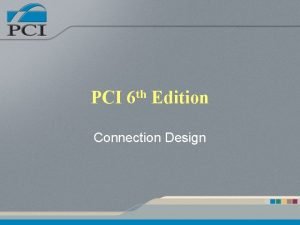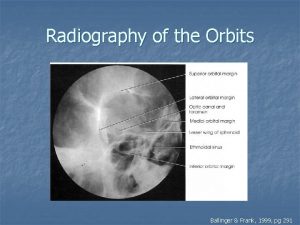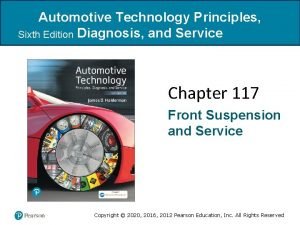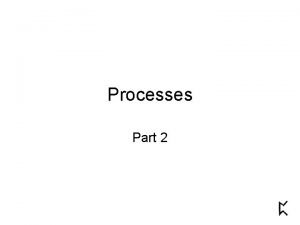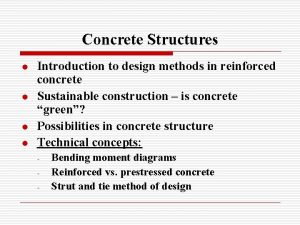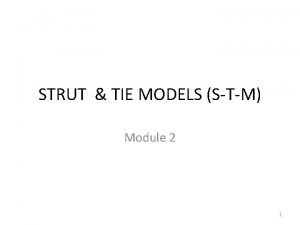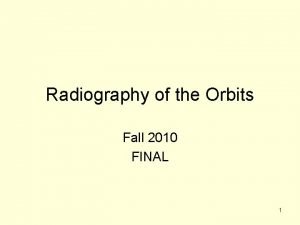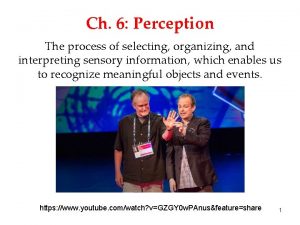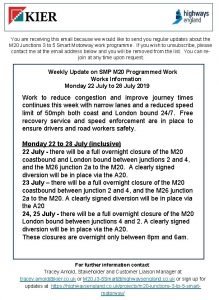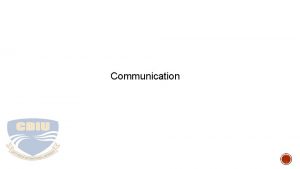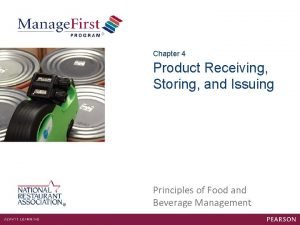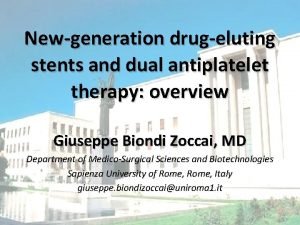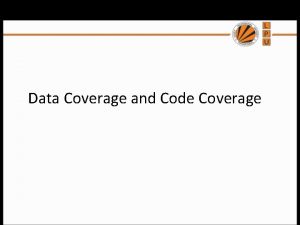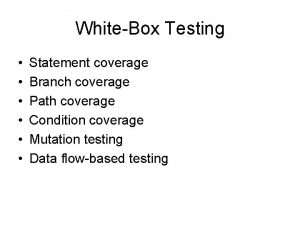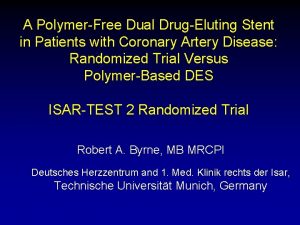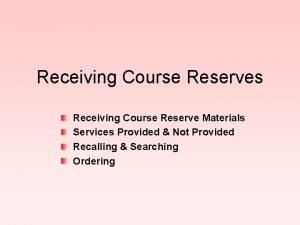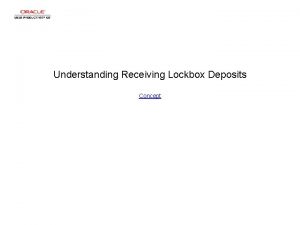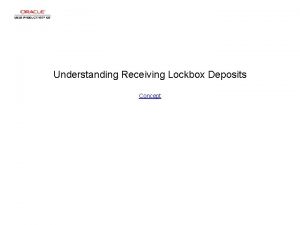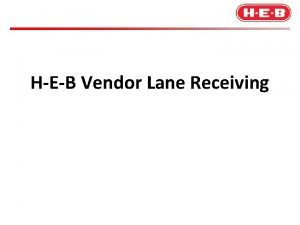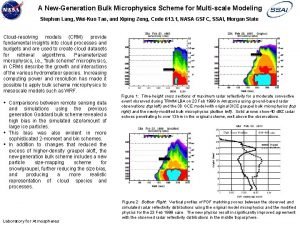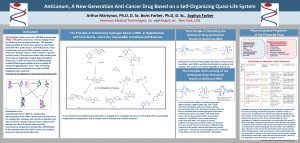Early strut coverage in patients receiving newgeneration drugeluting























- Slides: 23

Early strut coverage in patients receiving new-generation drug-eluting stents and its implications for dual antiplatelet therapy: a randomized clinical trial Myeong-Ki Hong, MD. Ph. D on behalf of the DETECT OCT trial investigators Severance Cardiovascular Hospital and Cardiovascular Research Institute, Yonsei University College of Medicine, Seoul, Korea

Conflict of Interest • I have nothing to disclose

Background • Adverse cardiac events after drug-eluting stent (DES) implantation have been associated with the delayed healing of stented artery 1. Joner M, et al. J Am Coll Cardiol 2006; 48: 193 -202 2. Finn AV, et al. Circulation 2007; 115: 2435 -41 3. Souteyrand G, Eur Heart J 2016; 37: 1208 -16 • The delayed healing of a stented artery requires an extended duration of dual antiplatelet therapy (DAPT) • The improvement of DES strut coverage may be translated into an early discontinuation of DAPT.

Study Design • • Seven centers in Korea Enrollment period: between January 2013 and April 2016 • Eligible participants • • at least 20 years old typical angina and evidence of objective myocardial ischemia significant coronary artery stenosis (>70% of DS by visual estimation) anticipated 24 -mm or shorter stent implantation

Study Flow 1, 100 patients requiring DES implantation with two-by-two factorial design EES (Xience) vs. BES (Nobori) were randomized OCT vs. angiography guidance were randomized Primary outcome: percentage of uncovered strut at 3 months by OCT Uncovered strut ≤ 6. 0% Uncovered strut > 6. 0% Stop clopidogrel (3 -month DAPT) Continue clopidogrel (12 -month DAPT) Secondary outcome: cardiac death, MI, stent thrombosis, and major bleeding at 12 months

Hypotheses • Randomization with two-by-two factorial design 1. EES would show better strut coverage than BES at 3 -month follow-up OCT 2. OCT-guided stent implantation would show better strut coverage than angiography-guided stent implantation at 3 -month follow-up OCT. • We also examined clinical outcome with observational cohort manner… 3. Three-month DAPT based on a favorable degree of strut coverage would show similar long-term clinical outcomes as 12 -month DAPT due to a poor degree of strut coverage

Procedures • DESs: EES (Xience®, Abbott Vascular) and DES (Nobori®, Terumo) • Criteria for optimal DES implantation • Angiography guidance: residual DS <20% by visual estimation and absence of angiographically detected dissection • OCT guidance: minimal stent cross-sectional area >4. 0 mm 2 and minimal degree of stent strut malapposition • Discontinuation of clopidogrel at 3 -month follow-up • If percentage of uncovered strut was <6%, clopidogrel was discontinued (Won H, et al. Int J Cardiovasc Imaging 2013; 29: 1255 -63) (3 month DAPT and then aspirin alone) • Otherwise, clopidogrel was maintained for at least 12 months after DES implantation (12 -month DAPT)

Outcomes • Primary outcome: the difference in early strut coverage 1) between EES and BES groups and 2) between OCT- and angiography-guided implantation group • Early strut coverage: measurement of the percentage of uncovered struts upon 3 -month follow-up OCT • Secondary outcome: a composite of cardiac death, myocardial infarction, stent thrombosis, and major bleeding during the first 12 months after hospital discharge among patients who received 3 -month or 12 -month DAPT after DES implantation depending on the degree of strut coverage at 3 -month follow-up

OCT analyses of strut coverage and apposition • analyzed at 1 -mm intervals • • struts were classified as uncovered, if neointimal thickness of the strut was zero struts were classified as malapposed, if it did not abut the vessel wall and its detachment from the vessel wall was ≥ 100 μm for Xience® or ≥ 130 μm for Nobori® • struts were classified in 4 categories • • covered embedded (A): covered by tissue and not otherwise interrupting the lumen covered protruding (B): covered by tissue but extending into the lumen uncovered apposed (C): not covered by tissue but abutting the vessel wall uncovered malapposed (D): not covered by tissue and not abutting the vessel wall Guagliumi G, et al. Circulation 2011; 123: 274 -81

A covered B covered C uncovered D uncovered

Sample size calculation • Superiority design • Two-sided with Bonferroni correction of 2. 5% and statistical power of 90%, drop out of 10% • Assuming the uncovered strut of EES and BES to be 3. 7% and 14. 4%, respectively (standard deviation, 10. 1) requiring a sample size of 33 patients for each group • Assuming the uncovered strut of OCT guidance to be reduced by 25%, compared with angiography guidance requiring 495 patients for each group • Therefore, 550 patients for each group were needed in this study

Statistical Analysis • Intention-to-treat analysis • Primary outcome: Hierarchial multilevel regression model including patients and participating centers as random effects • Secondary outcome: Kaplan-Meier estimates with log-rank tests

Results • The trial was prematurely terminated for • low event rate in patients with 3 -month DAPT • slow recruitment • halted production of Nobori® stents by the manufacturer • Therefore, 894 (81· 3%) of 1, 100 planned patients were randomly assigned

Participant Flow 8, 756 assessed for eligibility 894 were enrolled and randomized with two-by-two factorial design 444 (EES) vs. 450 (BES) were randomized 222 were assigned to EES and OCT guidance 4 did not undergo OCT guidance 29 did not undergo 3 -month OCT 222 were assigned to EES and angiographic guidance 1 underwent OCT guidance 1 withdrew consent after PCI 21 did not undergo 3 -month OCT 7, 862 were excluded 4, 722 did not meet study criteria 1, 823 refused to participate 1, 204 included in other study 73 withdrew consent 40 were withdrawn by investigators 445 (OCT guidance) vs. 449 (angiographic guidance) were randomized 223 were assigned to BES and OCT guidance 6 did not undergo OCT guidance 26 did not undergo 3 -month OCT 227 were assigned to BES and angiographic guidance 1 received EES 30 did not undergo 3 -month OCT

Baseline Characteristics EES BES OCT guidance Angiography guidance 444 450 445 449 Age (years) 63 (56– 69) 63 (55– 69) 63 (56– 69) Men 330 (74%) 322 (72%) 324 (73%) 328 (73%) Diabetes mellitus 97 (22%) 111 (25%) 105 (24%) 103 (23%) Acute myocardial infarction 51 (11%) 54 (12%) 55 (12%) 50 (11%) One 289 (65%) 278 (62%) 280 (63%) 287 (64%) Two 113 (25%) 125 (28%) 117 (26%) 121 (27%) Three 42 (10%) 47 (10%) 48 (11%) 41 (9%) No. of patients No. of diseased vessels

Procedural Characteristics EES BES p OCT guidance Angiography guidance p Ref. vessel diameter (mm) 3. 04± 0. 49 3. 01± 0. 48 0. 3064 3. 04± 0. 46 3. 00± 0. 51 0. 2388 Minimal lumen diameter (mm) 0. 89± 0. 45 0. 85± 0. 40 0. 1508 0. 90± 0. 46 0. 85± 0. 39 0. 0759 Diameter stenosis (%) 70. 6± 14. 0 71. 5± 12. 8 0. 859 70. 5± 14. 2 71. 6± 12. 5 0. 2496 3. 23± 0. 42 3. 13± 0. 36 <0. 0001 3. 24± 0. 38 3. 13± 0. 40 <0. 0001 0. 6569 18. 0 (15. 0– 23. 0) 233 (50%) 0. 7033 0. 8008 18. 0 (15. 0– 18. 0) 271 (60%) Pre-intervention Stent diameter (mm) Stent length (mm) Adjuvant post-dilation 18. 0 (15. 0– 23. 0) (14. 0– 18. 0) 249 (55%) 255 (55%) 0. 0039 Post-intervention Minimal lumen diameter (mm) 2. 82± 0. 44 2. 78± 0. 43 0. 1790 2. 84± 0. 42 2. 75± 0. 44 0. 0020 Diameter stenosis (%) 10. 5± 7. 3 10. 2± 7. 4 0. 4805 9. 9± 7. 1 10. 9± 7. 6 0. 0394

Primary Outcome: percentage of uncovered strut EES vs. BES Mean difference of 0. 4% 95% confidence interval, -1. 6– 2. 4 p=0. 69 OCT vs. Angiography 7. 5% in OCT guidance and 9. 9% in angiography guidance 80 70 70 60 60 Uncovered strut (%) Median percentage of uncovered strut: 8. 9% in EES and 8. 2% in BES 80 50 40 30 20 10 Mean difference of 2. 8% 95% confidence interval, 0. 8– 4. 8 p=0. 009 50 40 30 20 10 0 0 Everolimus-eluting 0 457 stent 0 Biolimus-eluting 459 stent 0 OCT guidance 453 0 Angiography 463 guidance

Participant Flow 106 did not undergo 3 -month OCT 8 underwent repeated PCI of target vessel at 3 -month follow-up 1 withdrew consent Therefore, 779 (87. 1%) of 894 were available for DAPT decision at 3 -month follow-up according to the percentage of uncovered strut 320 (40. 7%) were eligible for 3 -month DAPT 459 were eligible for 12 -month DAPT 18 continued clopidogrel 4 restarted clopidogrel 320 were included in analysis (3 -month DAPT) 459 were included in analysis (12 -month DAPT)

Baseline and Procedural Characteristics No. of patients Age (year) Men Hypertension Diabetes mellitus Clinical diagnosis Stable angina Unstable angina Acute myocardial infarction Used drug-eluting stent EES BES Usage of OCT Stent diameter (mm) Stent length (mm) Adjuvant post-dilation 3 -month DAPT 320 62 (55– 69) 219 (68%) 164 (51%) 68 (21%) 12 -month DAPT 459 63 (56– 70) 347 (76%) 263 (57%) 104 (23%) 177 (55%) 111 (35%) 32 (10%) 256 (56%) 144 (31%) 59 (13%) 151 (47%) 171 (53%) 164 (51%) 3. 14 ± 0. 40 18. 0 (15. 0– 18. 0) 171 (53%) 248 (52· 5%) 224 (47· 5%) 220 (47%) 3. 22 ± 0. 39 18. 0 (15. 0– 23. 0) 272 (58%) p 0. 1050 0. 0274 0. 0952 0. 6411 0. 3763 0. 1181 0. 2315 0. 0118 0. 0413 0. 2078

Three-month OCT Findings 3 -month DAPT 12 -month DAPT Stent volume index (mm 3/mm) 7. 3 ± 2. 5 7. 8 ± 2. 2 Lumen volume index (mm 3/mm) 6. 8 ± 2. 3 7. 4 ± 2. 1 Neointima volume index (mm 3/mm) 0. 6 ± 0. 4 0. 3 ± 0. 2 No. of analyzed cross sections 5, 687 8, 476 Cross sections with any uncovered strut (%) 16. 7 (8. 0– 28. 0) 66. 7 (50. 0– 83. 3) Cross sections with uncovered strut >0. 3 (%) 0 (0– 0) 23. 5 (10. 7– 41. 7) Cross sections with any malapposed strut (%) 0 (0– 5. 3) 12. 5 (0– 30. 2) Maximal malapposed distance (μm) 250. 0 (180. 0– 410. 0) 285. 0 (190. 0– 460. 0) No. of analyzed struts 57, 771 88, 786 Uncovered struts (%) 2. 5 (1. 0– 4. 4) 17. 4 (10. 3– 27. 3) Malapposed struts (%) 0 (0– 0. 6) 1. 8 (0– 6. 1) p 0. 0116 0. 0002 <0. 0001 0. 1325 <0. 0001

Secondary Outcome Cardiac death MI Definite or probable ST Bleeding Major Minor Target-vessel revascularization A composite of cardiac death, MI, definite/probable ST, and major bleeding 3 -month DAPT (n=320) 0 1 (0. 3%) 0 1 2 (0. 6%) 1 (0. 3%) 12 -month DAPT (n=459) 0 0 0 3 (0. 7%) 1 2 2 (0. 4%) 1 (0. 2%) Difference (95% CI) p 0. 3% (-0. 3– 0. 9) -0. 3% (-1. 3– 0. 6) 0. 4108 0. 5138 0. 2% (-0. 9– 1. 2) 0. 1% (-0. 7– 0. 8) 0. 7175 0. 7967

Conclusions • Strut coverage at 3 -month follow-up OCT evaluation was similar for EES and BES. • OCT-guided DES implantation resulted in better strut coverage than angiography-guided DES implantation at 3 month follow-up. • Three-month DAPT based on a favorable degree of strut coverage upon OCT evaluation was feasible in selected patients receiving new-generation DES.

Dreams will come true
 Modified macpherson strut
Modified macpherson strut Strut presentation
Strut presentation Rhese method rheese orbits positioning
Rhese method rheese orbits positioning Modified macpherson strut
Modified macpherson strut Yod-dropping
Yod-dropping Paratech acme thread strut
Paratech acme thread strut To drive straight forward you should look
To drive straight forward you should look Concrete
Concrete Modified macpherson strut
Modified macpherson strut Strut and tie
Strut and tie Tripod fracture
Tripod fracture Early cpr and early defibrillation can: *
Early cpr and early defibrillation can: * Purchase food from reputable suppliers
Purchase food from reputable suppliers Putaway in warehouse
Putaway in warehouse A process of receiving selecting organizing
A process of receiving selecting organizing Sending and receiving signals are special constructs of
Sending and receiving signals are special constructs of The flow of food purchasing receiving and storage
The flow of food purchasing receiving and storage Receiving visitors in the office conversation
Receiving visitors in the office conversation Keeping the love tank full
Keeping the love tank full Taxonomy of affective domain
Taxonomy of affective domain Is a very shallow skillet with very short sloping sides
Is a very shallow skillet with very short sloping sides You are receiving this email because
You are receiving this email because Communication in general is process of sending
Communication in general is process of sending Storing and issuing
Storing and issuing

